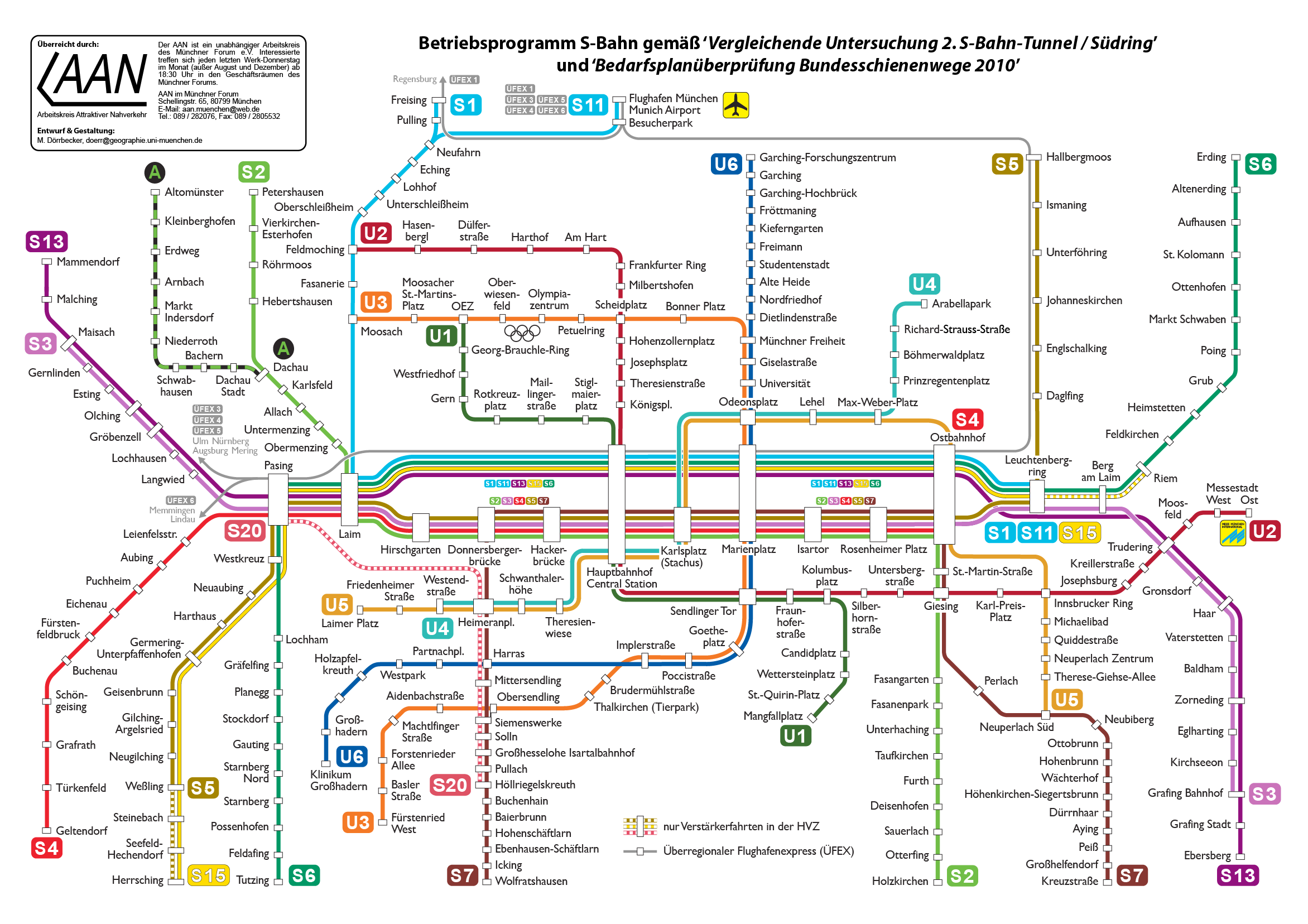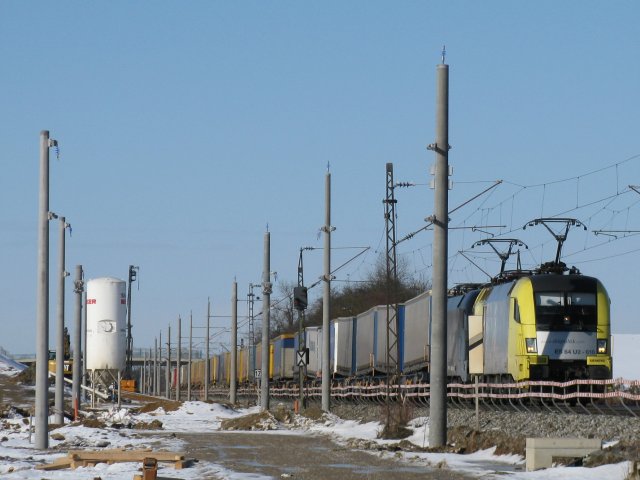|
S6 (Munich)
Line S6 is a line on the Munich S-Bahn network. It is operated by DB Regio Bayern. It runs from Tutzing station to Zorneding via Starnberg, Pasing, central Munich and Munich East. The line is operated at 20-minute intervals between Starnberg and Munich East. Two out of three trains an hour continue from Starnberg to Tutzing, so that the gap between trains alternates between 20 and 40 minutes. In the peak hour services are extended to and from Zorneding every 20 minutes. It is operated using class 423 four-car electrical multiple units, usually as two coupled sets. In the evenings and on Sundays they generally run as single sets. The line runs over lines built at various times: *from Tutzing to Pasing over the Munich–Garmisch-Partenkirchen railway The Munich–Garmisch-Partenkirchen railway is a single track, electrified main line railway in the southern part of the German state of Bavaria. It runs from Munich via Starnberg and Murnau to Garmisch-Partenkirchen. The f ... [...More Info...] [...Related Items...] OR: [Wikipedia] [Google] [Baidu] |
Munich S-Bahn
The Munich S-Bahn () is an Railway electrification system, electric rail transit system in Munich, Germany. "S-Bahn" is the German abbreviation for ''Stadtschnellbahn'' (literally, "urban rapid rail"), and the Munich S-Bahn exhibits characteristics of both rapid transit and commuter rail systems. The Munich S-Bahn network is operated by S-Bahn München, a subsidiary of DB Regio Bayern, which is itself a subsidiary of the German national railway company, Deutsche Bahn. It is integrated into the Munich Transport and Tariff Association (''Münchner Verkehrs- und Tarifverbund'', MVV) and interconnected throughout the city with the locally owned Munich U-Bahn. Today, the S-Bahn covers most of the populated area of the Munich metropolitan area of about 3 million inhabitants. In terms of system length, the Munich S-Bahn is the fourth-largest in Germany, behind the Rhine-Neckar S-Bahn, Rhine-Ruhr S-Bahn and the S-Bahn Mitteldeutschland. The Munich S-Bahn was established on 28 May 1972. ... [...More Info...] [...Related Items...] OR: [Wikipedia] [Google] [Baidu] |
DB Regio
DB Regio AG () is a subsidiary of Deutsche Bahn which operates regional and commuter train services in Germany. It is a 100% subsidiary of the Deutsche Bahn Group and therefore part of the DB Regio business segment, which also includes DB Regionnetz Verkehrs GmbH and other independent subsidiaries headquartered in Frankfurt am Main. The company as a mainly nationwide operational company is responsible for all regional transport activities ( rail and bus) of the DB Group in Germany. This includes traffic in neighboring countries. DB Regio serves 310 lines with 22,800 trains and 295,000 stops every day, serving about ten million customers. History Foundation and early years DB Regio AG emerged during the second stage of the rail reform on 1 January 1999, from the local transport division of Deutsche Bahn AG. Original plans were for them to be listed on the stock exchange by 2003. An IPO has not yet been implemented. The articles of association for DB Regio GmbH were conclud ... [...More Info...] [...Related Items...] OR: [Wikipedia] [Google] [Baidu] |
S4 (Munich)
Line S4 is a line on the Munich S-Bahn network. It is operated by DB Regio Bayern. It runs from Geltendorf station to Ebersberg station via Pasing station, Pasing, central Munich, Munich East station, Munich East and Grafing station. The line is operated at 20-minute intervals between Grafrath or Buchenau and Grafing station. Two out of three trains an hour continue from Buchenau to Geltendorf and from Grafing station to Ebersberg, so that the gap between trains alternates between 20 and 40 minutes. It is operated using DBAG Class 423, class 423 four-car electrical multiple units, usually as two coupled sets. In the evenings and on Sundays they generally run as single sets. The line runs over lines built at various times: *from Geltendorf to Pasing over the Munich–Buchloe railway, opened by the Royal Bavarian State Railways on 1 May 1873 *from Pasing to the approaches to Munich Central Station (''Hauptbahnhof'') over a section of the Trunk line (Munich S-Bahn), S-Bahn trunk l ... [...More Info...] [...Related Items...] OR: [Wikipedia] [Google] [Baidu] |
Munich–Rosenheim Railway
The Munich–Rosenheim railway is a 65 kilometre-long double-track main line of the Rail transport in Germany, German railways. It connects Munich Hauptbahnhof with Rosenheim station, where it connects with the Rosenheim–Salzburg railway, which connects with the Austrian Western Railway, line to Vienna at Salzburg Hauptbahnhof, Salzburg, and the Rosenheim–Kufstein railway, line to Kufstein, which continues to Innsbruck Hauptbahnhof, Innsbruck and the Brenner railway, Brenner line to Italy. The line is part of the "Main line for Europe", connecting Paris with Bratislava and Budapest and the almost identical line 17 of Trans-European Transport Networks (TEN-T). It is part of the Berlin–Palermo railway axis, line 1 of TEN-T. It is electrified at 15 kV AC railway electrification, 15 kV, 16.7 Hz. It was opened between Munich and Rosenheim in 1871. History Already in the 1860s, it was clear that the Mangfall Valley Railway (''Mangfalltalbahn''), which had been opened between ... [...More Info...] [...Related Items...] OR: [Wikipedia] [Google] [Baidu] |
Munich–Augsburg Railway
The Munich–Augsburg line connects München Hauptbahnhof, Munich and Augsburg Hauptbahnhof, Augsburg in the German state of Bavaria. It was built by the Munich-Augsburg Railway Company and opened in 1840. It was nationalised in 1846 and extended to Ulm in 1854. The line between Augsburg and Munich is a major traffic axis and part of the Magistrale for Europe from Budapest through Vienna to Paris. History The line was built by the Munich-Augsburg Railway Company (German language, German: ''München-Augsburg Eisenbahn-Gesellschaft'') and opened in 1839 and 1840. The Munich-Augsburg Railway Company was nationalised on 1 June 1846 and taken over by the Royal Bavarian State Railways (''Königlich Bayerische Staats-Eisenbahnen''). The line became part of Bavarian Maximilian’s Railway (''Bayerische Maximiliansbahn'') and was Augsburg–Ulm railway, extended to Ulm on 1 May 1854. After the nationalisation of the line in 1846 a new Augsburg station was built at Rosenauberg along with ... [...More Info...] [...Related Items...] OR: [Wikipedia] [Google] [Baidu] |
Trunk Line (Munich S-Bahn)
The Munich S-Bahn () is an Railway electrification system, electric rail transit system in Munich, Germany. "S-Bahn" is the German abbreviation for ''Stadtschnellbahn'' (literally, "urban rapid rail"), and the Munich S-Bahn exhibits characteristics of both rapid transit and commuter rail systems. The Munich S-Bahn network is operated by S-Bahn München, a subsidiary of DB Regio Bayern, which is itself a subsidiary of the German national railway company, Deutsche Bahn. It is integrated into the Munich Transport and Tariff Association (''Münchner Verkehrs- und Tarifverbund'', MVV) and interconnected throughout the city with the locally owned Munich U-Bahn. Today, the S-Bahn covers most of the populated area of the Munich metropolitan area of about 3 million inhabitants. In terms of system length, the Munich S-Bahn is the fourth-largest in Germany, behind the Rhine-Neckar S-Bahn, Rhine-Ruhr S-Bahn and the S-Bahn Mitteldeutschland. The Munich S-Bahn was established on 28 May 1972. ... [...More Info...] [...Related Items...] OR: [Wikipedia] [Google] [Baidu] |
Munich Central Station
Munich is the capital and most populous city of Bavaria, Germany. As of 30 November 2024, its population was 1,604,384, making it the third-largest city in Germany after Berlin and Hamburg. Munich is the largest city in Germany that is not a state of its own. It ranks as the 11th-largest city in the European Union. The metropolitan area has around 3 million inhabitants, and the broader Munich Metropolitan Region is home to about 6.2 million people. It is the List of EU metropolitan regions by GDP#2021 ranking of top four German metropolitan regions, third largest metropolitan region by GDP in the European Union. Munich is located on the river Isar north of the Alps. It is the seat of the Upper Bavaria, Upper Bavarian administrative region. With 4,500 people per km2, Munich is Germany's most densely populated municipality. It is also the second-largest city in the Bavarian language, Bavarian dialect area after Vienna. The first record of Munich dates to 1158. The city ha ... [...More Info...] [...Related Items...] OR: [Wikipedia] [Google] [Baidu] |
Weilheim In Oberbayern
Weilheim in Oberbayern (, ; officially Weilheim i.OB) is a town in Germany, the capital of the district Weilheim-Schongau in the south of Bavaria. Weilheim has an old city-wall, historic houses and a museum. Local history Up to the 18th century The oldest traces of human settlement date back to the Bronze AgeBernhard Wöll (Stadtarchiv Weilheim i. OB): ''Jubiläums-Chronik'' der Stadt Weilheim, anlässlich der 1000-jährigen erstmaligen urkundlichen Erwähnung im Jahr 1010 von Weilheim und Polling, Herausgeber: Stadt Weilheim i. OB 2010. and there were grave finds from the Late Roman era. The name Weilheim is interpreted as a home to the Roman villas (land estates). There are, however, several other theories for the roots of the name. Upper Bavaria came in Roman hands through commander Drusus.Sonderbeilage des Weilheimer Tagblattes anlässlich der 1000-jährigen erstmaligen urkundlichen Erwähnung der Orte Polling und Weilheim 16 April 2010, page 4. The Romans built "Via Rae ... [...More Info...] [...Related Items...] OR: [Wikipedia] [Google] [Baidu] |
Royal Bavarian State Railways
The Royal Bavarian State Railways (''Königliche Bayerische Staats-Eisenbahnen'' or ''K.Bay.Sts.B.'') was the state railway company for the Kingdom of Bavaria. It was founded in 1844. The organisation grew into the second largest of the German state railways (after that of the Prussian state railways) with a railway network of 8,526 kilometres (including the Palatinate Railway or ''Pfalzbahn'') by the end of the First World War. Following the abdication of the Bavarian monarchy at the end of the First World War, the 'Royal' title was dropped and on 24 April 1920 the Bavarian State Railway (''Bayerische Staatseisenbahn''), as it was then called, was merged into the newly formed German Reich Railways Authority or Deutsche Reichseisenbahnen as the Bavarian Group Administration (''Gruppenverwaltung Bayern''). The management of the Bavarian railway network was divided into four Reichsbahn divisions: Reichsbahndirektion Augsburg, Augsburg, Reichsbahndirektion München, Munich, Reichs ... [...More Info...] [...Related Items...] OR: [Wikipedia] [Google] [Baidu] |
Munich–Garmisch-Partenkirchen Railway
The Munich–Garmisch-Partenkirchen railway is a single track, electrified main line railway in the southern part of the German state of Bavaria. It runs from Munich via Starnberg and Murnau to Garmisch-Partenkirchen. The first part of it was opened in 1854 and is one of the oldest lines in Germany. On 3 June 2022 in the Burgrain train derailment, a regional train derailed on a single track curve at , north of Garmisch-Partenkirchen station. Route The line runs for 7.4 km from the Starnberg wing of Munich Hauptbahnhof to Munich-Pasing station. The route to Tutzing runs parallel to S-Bahn line S6. North and south of Starnberg the line follows the shore of Lake Starnberg, where the Alps can be seen. The S-Bahn line ends in Tutzing. The single-track, electrified Kochelsee line branches off to the southeast to Kochel. South of Tutzing the line leaves the shore. At Weilheim, the Ammersee line joins from the northwest and the Weilheim–Peißenberg line diverges t ... [...More Info...] [...Related Items...] OR: [Wikipedia] [Google] [Baidu] |
Munich East Station
Munich East station (, also called ''München Ostbahnhof'' in regional services) is a major railway station in Munich, the capital of Bavaria, Germany. The station opened in 1871 as Haidhausen station on the Munich–Mühldorf and Munich–Rosenheim railway lines. DB Station&Service, a subsidiary of Deutsche Bahn AG, operates the station. It is classified as a Category 1 station, one of 21 in Germany and one of two in Munich (the other is München Hauptbahnhof). Munich East is the city's third interregional station, along with München Hauptbahnhof in the city centre and München-Pasing in the west. History The first station, built according to plans designed by Friedrich Bürklein, was inaugurated on 1 May 1871 as part of the newly built railway line to Neuötting via Mühldorf am Inn. The line to Rosenheim opened on 15 October 1871. It was initially named ''Haidhausen'' after the eponymous quarter, but it received its present name ''München Ost'' on 15 October 1876. Th ... [...More Info...] [...Related Items...] OR: [Wikipedia] [Google] [Baidu] |






